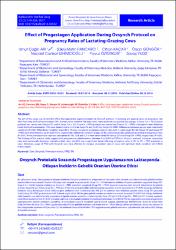Effect of progestagen application during ovsynch protocol on pregnancy rates of lactating- grazing cows

Göster/
Erişim
info:eu-repo/semantics/openAccessTarih
2017Yazar
Arı, Umut ÇağınPancarcı, Şükrü Metin
Kaçar, Cihan
Güngör, Orsan
Lehimcioğlu, Necdet Cankat
Öztürkler, Yavuz
Yıldız, Savaş
Üst veri
Tüm öğe kaydını gösterÖzet
The aim of this study was to test the effect of progesterone supplementation to Ovsynch protocol in lactating and grazing cows on pregnancy rate after fixed time artificial insemination (TAI). Animals, from a total of 158 dairy cows, were randomly assigned to two groups. In Grup 1 (n = 75) Ovsynch protocol was carried out (Group OV), and in Grup 2 (n = 83) Ovsynch + PRID protocol was carried out (Group OV + PRID). Conception rates following timed Artificial Insemination (TAI) were determined as 33.3% for Grup OV and 53.0% for Group OV+PRID. Differences between groups were statistically significant (P < 0.05). When Body Condition Score (BCS) of cows considered, pregnancy rates of cows with 2.5 and upper BCS for Group OV and Group OV + PRID were determined as 36.8% and 59.2%, respectively. Differences between groups for BCS were statistically significant according to pregnancy rates (P < 0.01). While premature heat rate was considered for TAI, 12.0 and 7.2 % were determined for Group OV and Group OV + PRID, respectively (P > 0.05). The findings of the present study suggest that progesterone administration between first GnRH to PGF2a in Ovsynch protocol increases conception rates and numerically decreases premature heat rates, also BCS was a significant factor affecting conception rates in OV or OV + PRID protocols in cows. Moreover, usage of PRID with Ovsynch was more effective to increase conception rates in cows with optimum body condition (2.5-4 BCS) in Kars region.

















